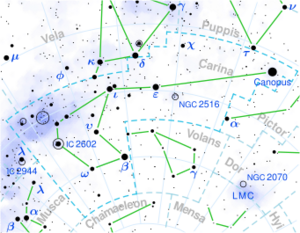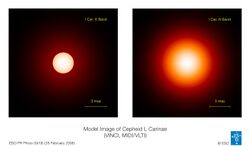Astronomy:HD 84810
| Observation data Equinox J2000.0]] (ICRS) | |
|---|---|
| Constellation | Carina |
| Right ascension | 09h 45m 14.81122s[1] |
| Declination | −62° 30′ 28.4519″[1] |
| Apparent magnitude (V) | 3.35 - 4.06[2] |
| Characteristics | |
| Spectral type | G5 Iab/Ib;[3] F6Ib-K0Ib[2] |
| U−B color index | +0.76[4] |
| B−V color index | +1.03[4] |
| Variable type | Classical Cepheid[2] |
| Astrometry | |
| Radial velocity (Rv) | +3.3[5] km/s |
| Proper motion (μ) | RA: −12.88[1] mas/yr Dec.: +8.19[1] mas/yr |
| Parallax (π) | 2.09 ± 0.29[1] mas |
| Distance | 498+55 −45[6] pc |
| Absolute magnitude (MV) | −5.22[7] |
| Details | |
| Mass | 8.4[3] to 13[8] M☉ |
| Radius | 169±8[9] R☉ |
| Luminosity | 11,482[6] L☉ |
| Surface gravity (log g) | 1.5[10] cgs |
| Temperature | 5,091[10] K |
| Metallicity [Fe/H] | 0.30[10] dex |
| Age | 31.25[6] Myr |
| Other designations | |
| Database references | |
| SIMBAD | data |
HD 84810, also known as l Carinae (l Car), is a star in the southern constellation of Carina. Its apparent magnitude varies from about 3.4 to 4.1, making it readily visible to the naked eye and one of the brightest members of Carina. Based upon parallax measurements, it is approximately 1,600 light-years (490 parsecs) from Earth.[1]
From the characteristics of its spectrum, l Carinae has a stellar classification of G5 Iab/Ib.[3] This indicates the star has reached a stage in its evolution where it has expanded to become a supergiant with 169 times the radius of the Sun.[9] As this is a massive star with 8[3]–13[8] times the mass of the Sun, it rapidly burns through its supply of nuclear fuel and has become a supergiant in roughly 17-19 million years, after spending 15–17 million years as a main sequence star.[8]
l Carinae is classified as a Cepheid variable star and its brightness varies over an amplitude range of 0.725 in magnitude with a long period of 35.560 days. This unusually long period makes it essential for calibrating the period-luminosity relation for Cepheid variables; additionally, it is one of the nearest Cepheid variables, making it relatively easy to observe.[6] The radial velocity of the star likewise varies by 39 km/s during each pulsation cycle.[12] Its radius varies by about 40 R☉ as it pulsates, reaching maximum size as its brightness is decreasing towards minimum.[6]
It has a compact circumstellar envelope that can be discerned using interferometry. The envelope has been resolved at an infrared wavelength of 10μm, showing a radius of 10–100 AU at a mean temperature of 100 K. The material for this envelope was supplied by mass ejected from the central star.[8]
The period of l Carinae is calculated to be slowly increasing and it is thought to be crossing the instability strip for the third time, cooling as it evolves towards a red supergiant after a blue loop.[6]
References
- ↑ 1.0 1.1 1.2 1.3 1.4 1.5 van Leeuwen, F. (2007), "Validation of the new Hipparcos reduction", Astronomy and Astrophysics 474 (2): 653–664, doi:10.1051/0004-6361:20078357, Bibcode: 2007A&A...474..653V.
- ↑ 2.0 2.1 2.2 Samus, N. N. et al. (2009). "VizieR Online Data Catalog: General Catalogue of Variable Stars (Samus+ 2007-2013)". VizieR On-line Data Catalog: B/GCVS. Originally Published in: 2009yCat....102025S 1: B/gcvs. Bibcode: 2009yCat....102025S.
- ↑ 3.0 3.1 3.2 3.3 Tetzlaff, N.; Neuhäuser, R.; Hohle, M. M. (January 2011), "A catalogue of young runaway Hipparcos stars within 3 kpc from the Sun", Monthly Notices of the Royal Astronomical Society 410 (1): 190–200, doi:10.1111/j.1365-2966.2010.17434.x, Bibcode: 2011MNRAS.410..190T.
- ↑ 4.0 4.1 Madore, B. F. (June 1975), "Photoelectric UBV photometry of Cepheids in the Magellanic Clouds and in the southern Milky Way", Astrophysical Journal Supplement Series 29: 219–284, doi:10.1086/190342, Bibcode: 1975ApJS...29..219M.
- ↑ Evans, D. S. (June 20–24, 1966), Batten, Alan Henry; Heard, John Frederick, eds., "The Revision of the General Catalogue of Radial Velocities", Determination of Radial Velocities and Their Applications, Proceedings from IAU Symposium No. 30 (University of Toronto: International Astronomical Union) 30: 57, Bibcode: 1967IAUS...30...57E.
- ↑ 6.0 6.1 6.2 6.3 6.4 6.5 Neilson, Hilding R; Engle, Scott G; Guinan, Edward F; Bisol, Alexandra C; Butterworth, Neil (2016), "The Secret Lives of Cepheids: Evolution, Mass-Loss, and Ultraviolet Emission of the Long-period Classical Cepheid", The Astrophysical Journal 824 (1): 1, doi:10.3847/0004-637X/824/1/1, Bibcode: 2016ApJ...824....1N.
- ↑ Fouqué, P.; Arriagada, P.; Storm, J.; Barnes, T. G.; Nardetto, N.; Mérand, A.; Kervella, P.; Gieren, W. et al. (2007). "A new calibration of Galactic Cepheid period-luminosity relations from B to K bands, and a comparison to LMC relations". Astronomy and Astrophysics 476 (1): 73–81. doi:10.1051/0004-6361:20078187. Bibcode: 2007A&A...476...73F.
- ↑ 8.0 8.1 8.2 8.3 Kervella, P.; Mérand, A.; Gallenne, A. (2009), "The circumstellar envelopes of the Cepheids ℓ Carinae and RS Puppis. Comparative study in the infrared with Spitzer, VLT/VISIR, and VLTI/MIDI", Astronomy and Astrophysics 498 (2): 425–443, doi:10.1051/0004-6361/200811307, Bibcode: 2009A&A...498..425K.
- ↑ 9.0 9.1 Davis, J. et al. (April 2009), "Observations of the pulsation of the Cepheid l Car with the Sydney University Stellar Interferometer", Monthly Notices of the Royal Astronomical Society 394 (3): 1620–1630, doi:10.1111/j.1365-2966.2009.14433.x, Bibcode: 2009MNRAS.394.1620D.
- ↑ 10.0 10.1 10.2 Luck, R. E. (September 1979), "The chemical compositions of nine southern supergiant stars", Astrophysical Journal, Part 1 232: 797–806, doi:10.1086/157340, Bibcode: 1979ApJ...232..797L.
- ↑ Light Curve, ESA, https://www.cosmos.esa.int/web/hipparcos/java-tools/light-curve, retrieved 17 February 2022.
- ↑ Klagyivik, P.; Szabados, L. (September 2009), "Observational studies of Cepheid amplitudes. I. Period-amplitude relationships for Galactic Cepheids and interrelation of amplitudes", Astronomy and Astrophysics 504 (3): 959–972, doi:10.1051/0004-6361/200811464, Bibcode: 2009A&A...504..959K.
 |




